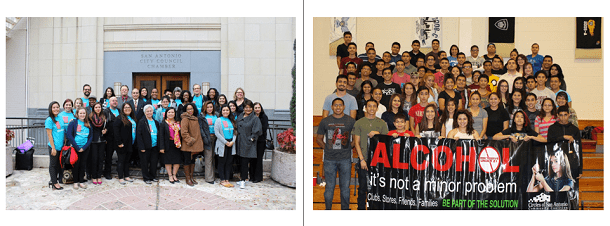
Tell me about your community and the communities that your coalition serves – its population and unique features. When was the coalition formed?
Circles of San Antonio Community Coalition was founded in 1998. The coalition services Bexar County, the 4th largest county in Texas with an estimated population of more than 1.89 million. The coalition’s Drug Free Communities (DFC) grant target is an inner-city area of approximately 80 square miles with a population of 306,943 within 19 target zip codes and within the boundaries of the San Antonio Independent School District. The demographic makeup of the target population is 77.3% Hispanic, 13% White Non-Hispanic, and 8.2 % African American. Within the target population, 91.6% of people are economically disadvantaged and the median income is $28,988.
What unique issues is your coalition facing?
“The social acceptance of alcohol and the drinking culture of San Antonio is not specifically unique to San Antonio,” said Coalition Coordinator Boyd Baxter. “However, Bexar County has long been on top of the charts when it comes to data related to traffic fatalities in connection to alcohol consumption. Texas leads the nation in alcohol-related traffic fatalities. At times, Bexar County has been the leader in the state in alcohol related fatalities per capita.”
“Each year, since 1891, San Antonio commemorates the heroes of the Battles of the Alamo and San Jacinto with the world’s premier cultural festival ‘Fiesta.’ For two weeks each April, the festival showcases cultural citywide celebrations and community events. Unfortunately, during many of these festival activities, partygoers may have too much alcohol to drink. Fiesta is not the sole reason for San Antonio’s alcohol problem, but with all the partying atmosphere going on, this provides the community with a relaxed social acceptance of alcohol consumption. For many, Fiesta has become a reason to party.”
“Today’s youth have adopted the culture of alcohol consumption through a variety of other seasonal events like Halloween, graduation, and spring break. An atmosphere long engrained in cultural acceptance has by nature fueled ease of the social access of alcohol among our youth.”
What activity or program is your coalition most proud of and/or what activity would you like us to spotlight?
“On December 15, 2016, San Antonio became the second city in Texas, and the largest city in the United States, to pass a civil social host ordinance,” said Baxter. “Circles of San Antonio Community Coalition members spent four years working on this initiative. The San Antonio Social Host Ordinance holds a homeowner and/or private property owner, or renter, responsible when they allow minors with the environment to drink alcohol. By imposing civil fines with each offense, the goal is to discourage underage drinking at parties.”
How did you get there, and what are your outcomes?
“It all started in 2012 when coalition members and staff of the Circles of San Antonio Community Coalition attended the ‘Texans Standing Tall – San Antonio Forum on Underage Drinking’ hosted by the San Antonio Council on Alcohol and Drug Awareness and The University of Texas San Antonio,” said Baxter. “It was at this forum where the coalition learned that not only was alcohol the most often used substance among youth in Bexar County, but youth had reported that their average age of first use was 11.3 years old. We also learned that up to 63% of secondary students, middle and high school age, reported that house parties, friends, peers and adult purchasers in all social settings, were where they got and consumed alcohol. Over the next several years, the coalition hosted town hall forums on underage drinking and met with coalition partners and community leaders to educate them on the impact of underage drinking.”
“Circles of San Antonio has developed successful collaborations with law enforcement and has built good relationship with the San Antonio Police Department (SAPD),” said Baxter. “After completing a presentation on social access of alcohol and controlled party dispersal to the SAPD team, the coalition received a call from a police lieutenant interested in the controlled party dispersal training. The lieutenant explained that the unit he commanded was responsible for assisting with back up and support services when calls were made for underage drinking parties. The San Antonio Police lieutenant helped the coalition to secure a presentation opportunity to the San Antonio Police Department’s police chief and command staff. Coalition members and staff presented the initiative and received 100% approval from the police chief and his staff. At that point, the police chief instructed the legal team to begin to draw up an ordinance that would he would present to city council.”
“Since the Social Host Accountability Ordinance passed in 2016, the coalition has been focusing on educating the community using a media-based strategy on the ordinance and underage drinking issues related to social access of alcohol at house parties. This media campaign can be found on Twitter by using the hashtag #NOPARTYPARENTS.”
“The implementation of the social host ordinance requires the coalition to fully understand the process of enforcement and implementation of the civil penalty when appropriate. Collaborative efforts with the San Antonio Police Department have continued to be productive. Circles of San Antonio continues to work on a social host accountability implementation and follow up. Monitoring the effectiveness of the ordinance is a top priority for the coalition. The coalition’s collaboration with the city of San Antonio and the San Antonio Police Department (SAPD) produced an internal training video to educate their officers on the new ordinance. The coalition has assisted the police department to produced ‘violation notice cards’ to be distributed to all the substation precincts in San Antonio. These information cards will remind officers that there is another tool they can use and will be sent to individuals that are found to be in violation with the city ordinance.”
What advice would you give to other coalitions that may be addressing some of the same issues?
“The coalition has learned that it is imperative to have a strong collaborative relationship with law enforcement when working to create and implement possible ordinances and ensure that they are enforced,” said Baxter.
“Be ready to stay committed for the long haul. It will be a long journey full of roller coaster ups and downs. Do not get discouraged when you know what is right. Make sure all your coalition members understand that the process will take a long time and that at times it may seem like the effort is too much. If your coalition is fortunate enough to be responsible for change, then they will need to carry out the mission long after the policy is adopted to ensure that it is successful and is not just another line item in the system of regulations.”
What’s something unique about the Dallas/Grapevine area that coalitions should experience or that makes it a great choice for Mid-Year Training?
“The Dallas/Grapevine area is rich with Texas history and culture,” said Baxter. “There is an enormous amount of entertainment available. Attendees can also hop on over to the Fort Worth Stockyards National Historic District and take in a night of Texas two-stepping and a world-class steak dinner.”

